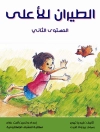Did you know tears have special powers and there are different types of them? This enthusiastic team of young scientists sets up a laboratory in a garage to study tears and all the different things they can be used for. They are about to become explorers, in a sea of emotions!
Peter and his friends have discovered an unprecedented fact… the magic of tears can be used for many things! Good scientists as they are, they have set up their own laboratory in Amy’s grandma’s garage and have noted that each tear is born from a different emotion. Who said you can only cry when you are sad?
After spending a long time collecting tears in lachrymatories, this group of friends has discovered and classified ten different types of tears. Silky tears, First Time tears, Chilly tears, Prickly tears, Goodbye tears, even of Sparkly Tears! All tears contain a different emotion within them, and that makes them so precious.
Behind every tear, there’s an embrace, and in that embrace… you’ll feel safe.
¿Sabías que las lágrimas tienen poderes especiales y que no todas son iguales? Este entusiasta equipo de jóvenes científicos ha instalado en un garaje su laboratorio para estudiarlas. ¡Se van a convertir en exploradores de todo un mar de emociones!
Pedro y sus amigos han descubierto un hecho inaudito… ¡la magia de las lágrimas puede utilizarse para muchísimas cosas! Como buenos científicos, han montado su propio laboratorio en el garaje de la abuela de Esther y han observado que cada lágrima nace de una emoción diferente. ¿Quién dijo que solo se puede llorar cuando estamos tristes?
Tras mucho tiempo recolectando lágrimas en lacrimatorios, este grupo de amigos ha investigado y clasificado diez tipos de lágrimas diferentes. Lágrimas de seda, de primera vez, de frío, de risa, de coco, de trompazo, de estornudo, de pelear, de adiós, ¡incluso de picapica! Todas las lágrimas contienen una emoción diferente, y por eso son tan especiales.
Detrás de cada lágrima hay un abrazo y en ese abrazo… te sentirás a salvo.
About the author
The award-winning author Marta Sanmamed is a plastic artist, writer, and cartoonist from Madrid and has exhibited not only in Spain but also in the US and Europe, and her work is part of prominent Museums and Private Collections. For over a decade, she has been committed to Residualism to ‘create from waste without generating more waste’ and within this movement are vertical Giardinos, woven from reused plastic bags. She firmly believes that Residualistic Art is the reflection of the human awakening towards a conscious, compassionate, understanding, honest, grateful, and respectful way of life with nature and tries to dignify creativity aimed at the preservation of our ecosystem. Her book Cyparissus (Cuento de Luz, 2015) has been translated into more than five languages and has been awarded by the prestigious IPPY AWARDS, Living Now Books Awards, and the International Latino Book Awards.
Mar Azabal is a graduate in Geography, specialising in Administration and archive conservation. Her real dream was to create stories through drawing and illustration. She currently lives in Toledo, Spain, and spends her time teaching illustration courses for children, creating stories, and enjoying raising her little child. In 2018 he illustrated the picture book Ayobami and the Names of the Animals (Cuento de luz, 2018), which won the Silver Medal at the 2018 Moonbeam Children’s Book Awards and Gold Medal at the International Latino Book Awards.












